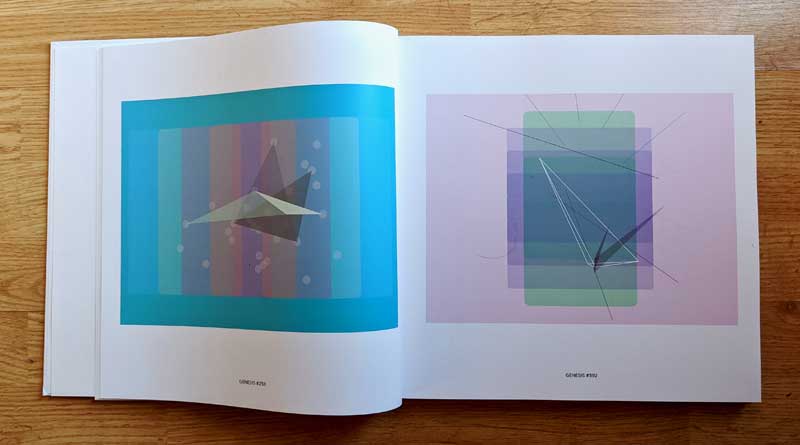
The photo above is of a catalog. It’s a hefty thing, of the kind you might buy after going to an art exhibition at a major gallery or museum.
It’s a beautifully produced book that weighs in at more than 4 pounds, with over 250 pages.
But I didn’t buy it after going through an exhibition in real life.
It was sent to me by artist Daniel Calderon, because I purchased one of his NFTs… Genesis #494.
The catalog includes images of all the pieces in that series, plus everything from his other collections, Gen 2 and Gen 3.
There is something beautiful about this.
People refer to NFTs as right-click-and-save jpegs. That kind of attitude is pretty dismissive of the many amazing artists who are now creating new works as NFTs.
We shouldn’t need a 4-pound, 250-page reminder of the true value of the art we collect.
But in a way, it is reassuring.
Prints of two NFTs I have purchased from other artists are also on the way. Once they arrive, I’ll be able to enjoy them digitally, and as framed prints on the wall.
All the NFTs I own are “real”… but it feels good when some of them jump over into the physical world.
NFTs with one foot in the real world are more likely to survive massive bear markets.
Whether the bear market we are seeing now qualifies as massive, I have no idea. Ask me in ten years.
As a collector who genuinely loves art… but also wants to build a collection of enduring financial value… I look for artists who have a history in the physical world.
For artists who jumped in the NFT bandwagon a couple of months ago and are trying to make a few bucks… fair enough… but any bear market will likely hit them the hardest.
However, when I collect work by Jeff Davis, I feel a lot more confident that his work will hold its value over the long term. How come? Because he has been creating art for decades, and I can sit and watch a video of him talking about his new work in a physical gallery in Chicago.
I love the piece I have by Alida Sun. And I feel inspired when I see the amazing experiences she creates with dance and light in real life. Follow her on Twitter and you’ll see what I mean.
I have pieces by Jorge Ledezma… and can also look at photos of the murals he has painted in Panama.
The point is, most generative artists have a history in the physical world.
To me, that gives them a whole different level of credibility. It provides a foundation that will help protect them against the wild ups and downs of the digital world.
This can work the other way around too.
I bet there are some great artists who are starting out 100% digital, but will find ways to express their work in the physical world before too long.
We see this already with a few PFP avatar projects.
There are thousands of these projects now. My guess is that many will whither and disappear.
But some are already making the jump into the physical world.
For example, if you own a piece from the Bored Ape Yacht Club collection, you may already have purchased a hoody or t-shirt. Or you might have been one of the thousands of apes who gathered together at NFT NYC. Or you might be looking forward to visiting the physical yacht club they plan to purchase in Miami.
One foot in each world…
One way or another… and this is my opinion only… is seems to me that the NFT projects that are most likely to endure are those that find expression in both the digital and physical worlds.
It turns out this isn’t just a metaverse thing.